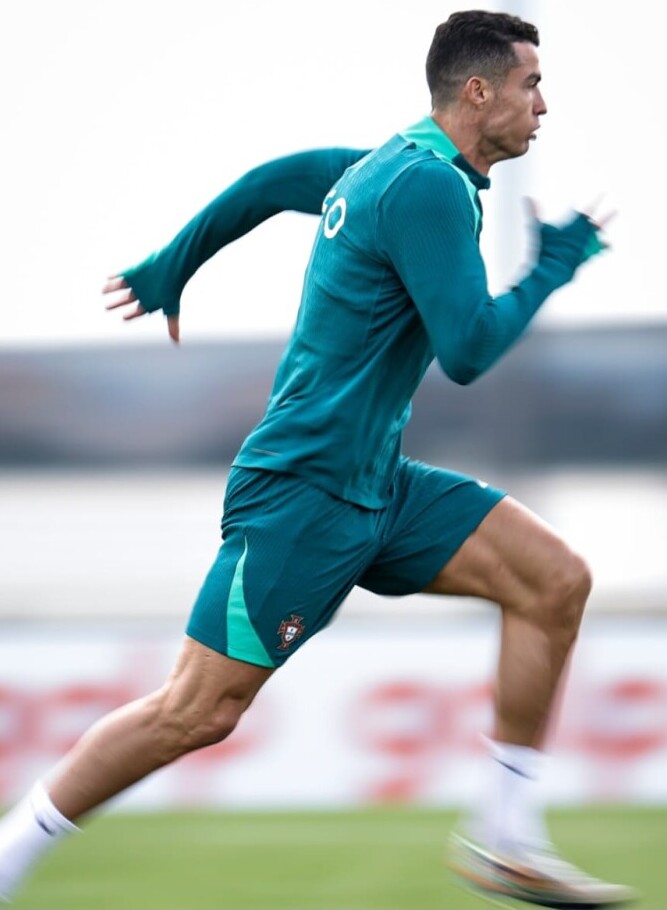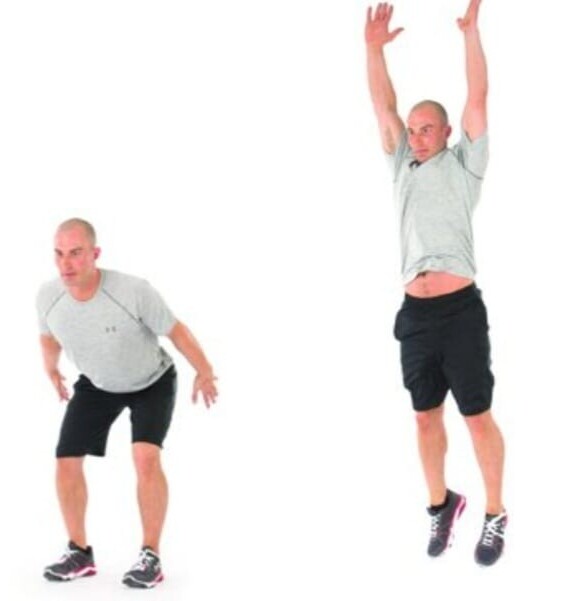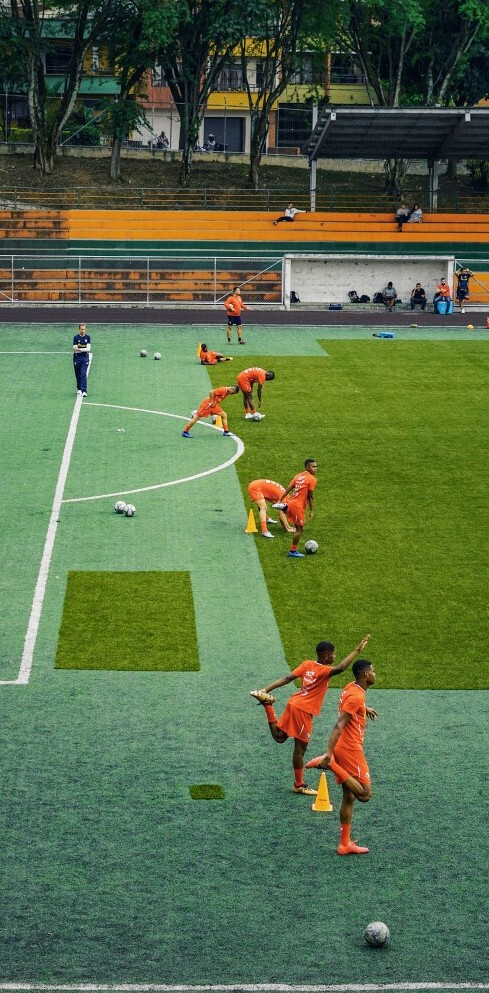Speed is a key factor that separates good soccer players from great ones.
Whether you’re breaking away for a solo goal or rushing back to make a defensive play, speed is essential for outpacing your opponents and dominating the field.
Improving your speed isn’t just about running faster; it’s about developing strength, agility, and power, all while maintaining endurance.
Incorporating interval and speed training drills into your routine is the most effective way to achieve this.
In this article, we’ve compiled the top 12 soccer training drills for speed that target various physical components—from explosive power to reaction time—to make you faster and more agile.
Let’s dive in!
a . Power Skips for Height
How to Do It:
Start with your feet shoulder-width apart. Drive one knee upward while swinging your opposite arm forward. Jump upward as high as you can, then switch legs mid-air. Land softly and repeat the cycle.
Benefits:
- Boosts vertical jump power, improving explosive takeoff.
- Increases leg strength and coordination, translating to faster sprints.
- Improves balance, crucial for quick acceleration.
Pro Tip: Start with 3 sets of 10 skips per leg and gradually increase intensity.
b . Power Skips for Distance
How to Do It:
Perform the same skipping motion as the height drill, but focus on covering as much distance as possible with each skip. Push off explosively while swinging your arms to create forward momentum.
Benefits:
- Strengthens the legs for greater stride length.
- Improves forward speed and efficient movement across the field.
- Enhances coordination and balance.
Pro Tip: Start with 3 sets of 10 skips per leg, aiming for longer skips as you build strength.
c . Single Leg Broad Jumps (Double and Triple)
How to Do It:
Stand on one leg, use your arms for momentum, and jump forward as far as you can. Land softly and maintain control. After mastering the single jump, progress to double or triple jumps.
Benefits:
- Improves unilateral leg strength, stability, and power.
- Helps with balance and coordination, key for soccer’s quick direction changes.
- Builds explosive power for sprints and quick starts.
Pro Tip: Begin with 3 sets of 5 jumps per leg and focus on maintaining soft, controlled landings.
d . Single Leg Box Jumps
How to Do It:
Stand on one leg, squat down slightly, and jump onto a sturdy box or platform. Land softly on the same leg, then step down and repeat.
Benefits:
- Builds explosive power in one leg at a time.
- Strengthens muscles needed for quick changes in direction.
- Improves balance and stability on the field.
Pro Tip: Start with a lower box height and gradually increase it as your strength improves.
e . Continuous Tuck Jumps
How to Do It:
From a standing position, squat and jump upward, pulling your knees toward your chest. Land softly and immediately spring into the next jump.
Benefits:
- Increases leg power and speed off the ground.
- Enhances endurance and fast-twitch muscle fiber activation.
- Improves cardiovascular fitness for sustained agility.
Pro Tip: Perform 3 sets of 10-15 jumps with brief rest periods between sets.
f . Cone Start/Stop Drills
How to Do It:
Set up cones in a straight line. Sprint to the first cone, stop quickly, then sprint to the next cone, and repeat. Focus on accelerating quickly and decelerating sharply at each cone.
Benefits:
- Enhances reaction time and quick bursts of speed.
- Builds agility and the ability to stop and start quickly.
- Simulates game-like changes in direction.
Pro Tip: Aim for 3-5 sets, focusing on explosive starts and sharp stops.
g . Falling Starts
How to Do It:
Stand upright, lean forward until you lose balance, and then use your lead foot to catch yourself and immediately explode into a sprint.
Benefits:
- Develops explosive first-step speed.
- Improves reaction time and sprint initiation.
- Prepares your body for fast starts during games.
Pro Tip: Perform 3-5 reps, focusing on a strong and quick reaction from the starting position.
h . Half Kneeling Start
How to Do It:
Start in a half-kneeling position, with one knee on the ground and the other leg bent at 90 degrees in front. Push off the front foot and explode into a sprint.
Benefits:
- Focuses on developing a powerful initial acceleration.
- Strengthens core and leg muscles for faster starts.
- Ideal for improving the first few steps of a sprint.
Pro Tip: Perform 3-5 sets per leg, emphasizing a smooth and quick push-off.
i . A-Skips
How to Do It:
Skip forward while driving your knees high, making sure your form stays controlled and rhythmic. Focus on a quick ground contact time and smooth arm-leg coordination.
Benefits:
- Improves stride efficiency and running form.
- Increases speed by improving arm-leg coordination.
- Enhances agility and overall running mechanics.
Pro Tip: Perform for 20 meters, focusing on form and knee height.
j . B-Skips
How to Do It:
Similar to A-Skips, but with an added element—kick your leg straight out in front after lifting your knee. This emphasizes hip flexor strength and coordination.
Benefits:
- Improves running mechanics and stride length.
- Boosts flexibility and range of motion for faster sprints.
- Enhances core strength for a better running posture.
Pro Tip: Perform over 20 meters, ensuring you focus on the controlled leg extension.
k . Straight Leg Bounds
How to Do It:
With your legs straight and knees locked, drive forward using your hips and arms. Push off powerfully and bound forward as far as possible.
Benefits:
- Strengthens hip flexors and legs for longer strides.
- Improves running economy and overall speed.
- Increases stride frequency and power.
Pro Tip: Start with 3 sets of 10 bounds and gradually increase distance over time.
l . Single Leg High Knees
How to Do It:
Stand on one leg, then drive your knee up as fast as possible while maintaining balance. Switch legs after each rep.
Benefits:
- Develops leg endurance and hip flexor strength.
- Improves balance and stability for quick directional changes.
- Increases overall running speed and agility.
Pro Tip: Perform for 20 meters, maintaining a quick and controlled pace.
Conclusion
Incorporating these 12 soccer training drills for speed into your routine will not only increase your top-end speed but also improve your agility, endurance, and acceleration—key components of a successful soccer player.
Whether you’re sprinting for a goal, chasing down an opponent, or quickly transitioning between defense and attack, these drills will ensure you’re prepared for any situation.
Remember, consistency is key. Incorporate these drills into your regular training schedule, and you’ll see improvements on the field in no time.
Stay disciplined, focus on technique, and most importantly—have fun as you elevate your soccer performance to new heights!
Please leave your message in the comment box below if you have any questions or experience about soccer training drills for speed.
Happy training!!!!!!!
Happy season!!!!!!!!



2 Responses
This is such a fantastic and detailed breakdown of speed drills for soccer players! I love how you not only explained the ‘how-to’ for each exercise but also the specific benefits and pro tips, makes it so actionable and easy to incorporate into a training routine.
The variety of drills ensures there’s something for everyone, whether they’re focusing on explosive power, endurance, or agility.
Quick question: For players who are just starting out with speed training, which drills would you recommend prioritizing to build a strong foundation without risking overtraining?
Also, how often should these drills be incorporated into a weekly schedule to see noticeable results?
Thanks for such a well-thought-out guide!
Thank you so much for your kind words.
I’m happy that you found the breakdown of the speed drills actionable and easy to incorporate into a training routine.
To answer your questions:
1. Drills for Beginners to Build a Strong Foundation
For players just starting out with speed training, it’s important to focus on drills that develop proper technique, balance, and strength without overloading the body. Here are my top recommendations:
High Knees: This drill is excellent for building running form, coordination, and explosive movement. It’s easy to learn and provides a solid base for other speed exercises.Cone Acceleration Sprints: These short, sharp sprints help players improve acceleration and form while keeping the distances manageable to avoid overtraining.Bounding (Explosive Jumps): Bounding helps beginners develop leg power and a longer stride without requiring high impact or intense repetitions.Side Shuffles: Agility-focused drills like side shuffles enhance lateral movement and coordination—key components of soccer speed.
Start with these drills, as they are effective for building speed and technique while minimizing the risk of injury.
2. How Often to Incorporate These Drills
For noticeable results, consistency is key. Here’s a suggested schedule:
Frequency: Start with 2-3 sessions per week to allow your muscles adequate time to recover between workouts. Recovery is just as important as the training itself, especially for beginners.Duration: Keep the sessions around 30-45 minutes, focusing on quality over quantity. Short, focused sessions with good form are more effective than long, drawn-out practices.Progression: After 4-6 weeks of consistent training, you can increase the intensity by adding resistance (e.g., resistance bands) or incorporating more advanced drills. Just ensure you’re listening to your body to avoid overtraining.
Additional Tips for Beginners
Warm-Up is Crucial: Before starting any speed drills, include a dynamic warm-up (e.g., light jogging, leg swings, and mobility exercises). This reduces the risk of injuries and prepares the muscles for explosive movements.Focus on Technique: For beginners, mastering proper form is more important than speed. Poor technique can lead to inefficiencies and injuries, so prioritize precision over speed during the early stages.Rest Periods: Allow ample rest between sets (30-60 seconds) to maintain high-quality repetitions. Fatigue can compromise form and reduce the effectiveness of the drills.
I hope this helps provide clarity and direction for beginners!
Thanks again for engaging with the article.